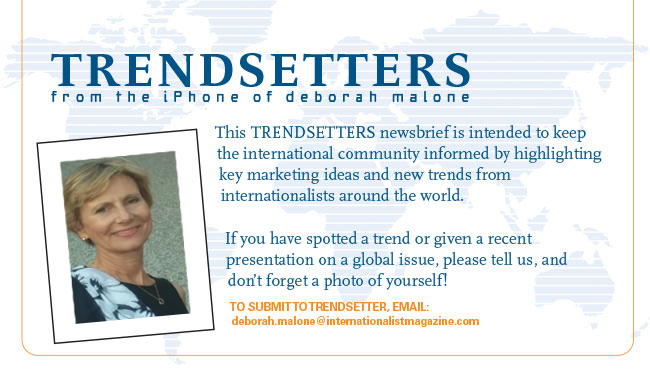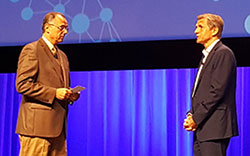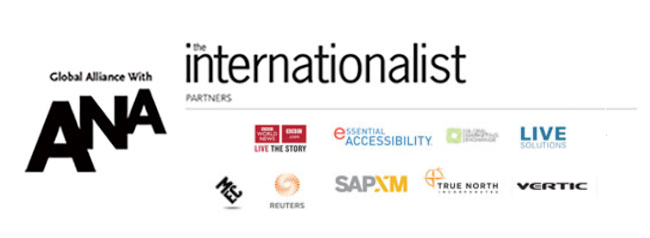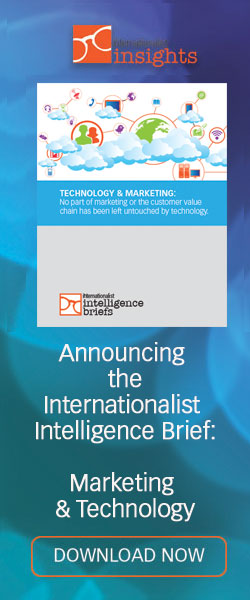

ANA's Bob Liodice and P&G's Marc Pritchard
See the current issue
of The Internationalist magazine
Find out how to sponsor an issue of Trendsetters
|
|
Trendsetters: P&G's Pritchard and ANA's Liodice Align on the New Responsibilities of Today's CMO
Without question, the role of a contemporary Chief Marketing Officer is exceedingly complex and constantly adapting to change. According to recent Internationalist Insights research on the "redefinition of the CMO," a majority of top marketing leaders believe a CMO is a visionary: a marketing leader with up-to-date skillsets, a growth mindset, and an ability to identify trends, inspire organizational change, and envision the way the company will engage and interact with consumers in the future.
Earlier this month in Orlando at the ANA's Masters of Marketing annual conference, the top marketer from the largest global advertiser and the CEO of the world's most significant marketing association addressed the state of the industry and advocated a way forward for marketers. While their speeches emphasized different elements of marketing's multifaceted issues, they were perfectly aligned in underscoring the need for greater CMO responsibility.
Bob Liodice, ANA's Chief Executive Officer, discussed the challenges of business growth and the need for marketers to "take back marketing" to revitalize the industry. Marc Pritchard, Procter & Gamble's Chief Brand Officer, followed by emphasizing that wasted expenditure in the digital ad space can be overcome with a focus on transparency, ad quality, and appropriate "mass one-to-one marketing," and messages for good.
Interestingly, a CMO has been called the "heart" of an organization in its need to connect with customer needs and consumer passions. The role has also been described as the "mind" of an organization as marketing strategy can build brand growth, public image and corporate stature.
The messages from Bob Liodice and Marc Pritchard are suggesting that in a Social Media Age that brings both disruption and the need for transparency, a CMO is also becoming the conscience of an organization.
According to Bob Liodice, the US marketing industry is suffering from sub-optimal growth, but the potential for recovery is in the hands of CMOs who must revitalize marketing and overcome barriers to growth. "CMOs," he said, "can no longer let others do the heavy lifting. It is time for chief marketing officers to seize ownership of the industry's growth agenda and point us all in the right direction."
He urged CMOs to make the difficult decisions needed to build brands and increase revenue by adopting steps recommended in a 12-point blueprint set forth by the ANA's CMO Masters Circle. The goals of the Masters Circle include:
- Advance the best brand and business intelligence for better marketing decision-making
- Develop industry talent and create high-quality business and brand leaders
- Harness the power of the industry's thinkers and leaders to shape the future of advertising and marketing and elevate growth performance
- Restore trust to the marketing ecosystem with agency and media partners to help facilitate growth
Bob Liodice also pointed out that in 2016 more than half of Fortune 500 companies had declining revenues despite a continued increase in media spending. He said the reason for the performance downturn was straightforward: "It boils down to a lack of effective marketing leadership. He stated that marketers continue to accept a "byzantine, non-transparent, super-complex digital media supply chain" that no one can understand, in which only 25 cents on every digital ad dollar reaches the consumer. "Yet," he added, "we keep feeding the beast by pouring incredible sums of money into this unproductive, unmanageable abyss."
Marc Pritchard echoed Bob Liodice's message by saying, "Despite an astounding $600 billion a year spent on marketing, our industries still aren't growing enough. We're holding stubbornly onto low single-digit market growth."
He outlined how Procter & Gamble has taken steps to change the way it works in the digital ad space. Transparency and Viewability are at the heart of the process. P&G, in partnership with the ANA and the IAB (Interactive Advertising Bureau), is adopting one viewability standard. According to Pritchard, we're doing this "so we know whether an ad has the chance to be seen." He added, "We're getting third-party, accredited measurement verification, so we know we're reaching the audience we paid for. We're demanding transparent agency contracts, so we know what our agencies do with our money. We're eliminating fraud, so we know humans see our ads, not robots. We're ensuring brand safety, so we know our ads show up in the right place, not in a terrorist video."
Marc Pritchard emphasized: "The consequences are clear for those who don't comply. We will vote with our dollars and will not waste our money on a crappy media supply chain so we can invest in what really matters—better advertising and innovation to drive growth."
MORE
From a global standpoint, Pritchard noted that P&G is working with ecommerce players like Amazon and Alibaba to use unique ID data to reach consumers closer to when they're ready to buy. He stated: "This is accelerating our $3 billion ecommerce business and cutting waste by 20 percent. But most important, it's creating a better consumer ad."
He admitted the P&G has found it was reaching too few people too many times with too many ads. "Excess frequency is a massive source of waste, and it really annoys consumers. No wonder ad blockers are growing 20 percent a year. I mean, how many times does a person need to see a toilet paper ad to get the point?" The company is working now with programmatic buying to serve ads when customers are most receptive, while they're also capping how often someone can see a message.
Marc Pritchard also serves as the Chairman of the ANA Board of Directors.


